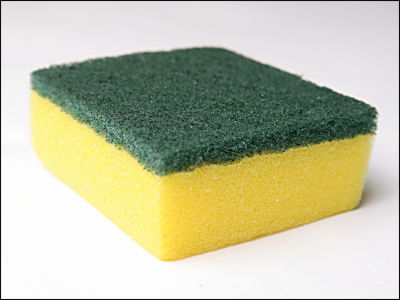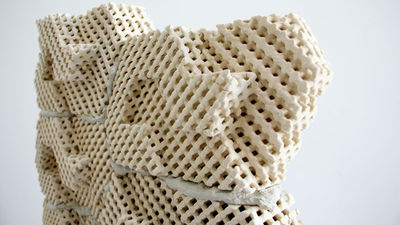A record of how to make perfect 'salt crystals' with high transparency, which took three years to create, is now available to the public.

Salt crystals can be created by slowly evaporating saturated salt water. It seems very simple and easy when you hear about it, but in order to create crystals with high transparency, it is necessary to control the evaporation process. If the evaporation process does not go well, the crystals may turn white and cloudy, or even melt, and small particles of dust may cause 'swarms of small crystals' that may not form into a clean rectangular parallelepiped. Therefore, Mr.
How to Grow Sodium Chloride Crystals at Home - Crystalverse
https://crystalverse.com/sodium-chloride-crystals/
The first step in making salt crystals is to make a saturated salt solution. Boil water in a pot, add 40g of salt per 100ml of water, and stir well to dissolve the salt. It's OK if some salt remains at the bottom of the pot, but you need to heat it until small chunks of salt float to the surface of the liquid. When you see chunks of salt floating on the surface of the liquid, turn off the heat and let it cool for a day.
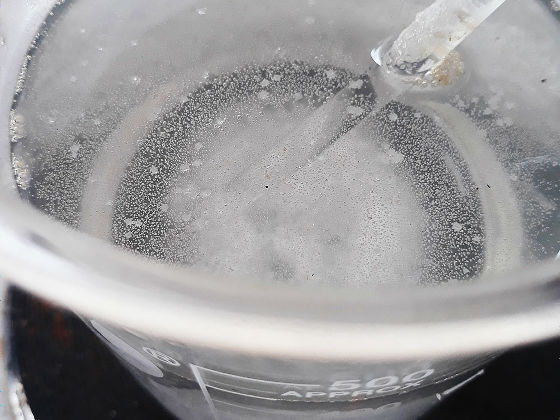
Once the solution has stabilized after a day, filter it through tissue paper or a coffee filter to remove excess salt and impurities, then pour the filtered solution into a flat dish. I used a Petri dish below, but any flat plate that is not made of metal will work. Pour approximately 50ml of solution to a depth of approximately 1cm.

If you leave the plate filled with the solution in a cool, dark place such as a cupboard or storeroom for 1 to 2 days, small crystals should form as shown below.
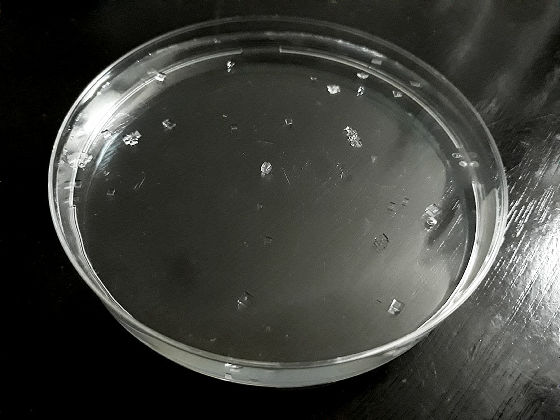
If the crystals look like this, the evaporation rate of the solution is too fast for some reason, such as ``the temperature is too high'' or ``the air conditioner's wind is hitting it.'' If the following situation occurs, you will need to start over from the beginning.
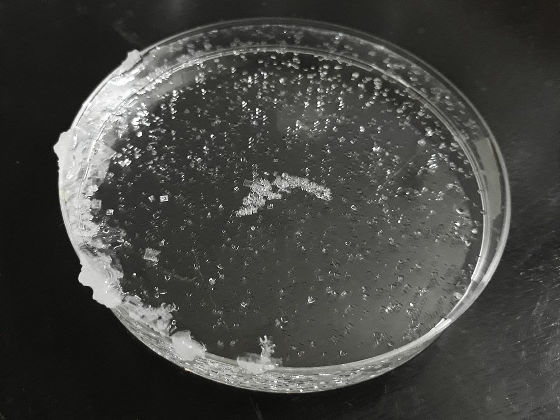
The method of 'suspending a thread in a solution' is often explained as a method for creating crystals, but sodium chloride is very delicate, and if a thread or the like enters the solution, 'highly transparent rectangular crystals' will grow. It seems that it will be inhibited. For this reason, Chase recommends the method of creating highly pure crystals by ``putting the solution in a small flat-bottomed container and growing the crystals in an environment with a low evaporation rate.'' Chase tried it out and found that a cosmetics case was the best choice.
Once you have a separate, dry container, pour the solution from earlier into it and use tweezers to gently transfer the 'crystal fragments' into it.

If you put 'crystal fragments' in four containers and grow crystals in environments with different evaporation rates, it will look like the following. The one on the left was grown in an environment with a slower evaporation rate, and the one on the right was grown in an environment with a faster evaporation rate. You can see that the faster the evaporation rate, the more cloudy the crystals become.
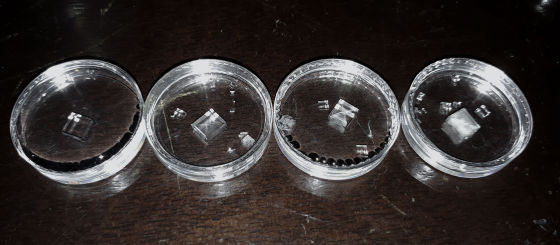
As described above, the slower the evaporation rate in an environment, the higher the transparency of the crystals. Therefore, in order to make highly transparent crystals, cover the container containing the crystals with a larger container as shown below, so that the surface of the solution is free from air. avoid exposure to Basically, this procedure should produce beautiful salt crystals.

...However, when you actually try it, the results seem to vary. Below, '1' is the ideal state. '2' has salt powder scattered around the crystal, and it is possible that the crystal was damaged when transferring the crystal fragments. ``3'' is a state in which the evaporation rate of the solution is too fast and cloudy as described above. ``4'' means that the humidity is too high or the solution is not saturated enough, and the crystals are starting to melt. In the case of '2', it is OK to move the crystal to another container and start growing it again. In the case of '3' and '4', although the conditions will not be as ideal as in '1', if you continue to grow them, 'interesting crystals' will be completed.

If you continue to grow '1' as it is, you will complete a flawless and beautiful crystal like the one below.

Below are a number of 'ideal crystals' created by Chase. All of them are over 1 cm in size, extremely transparent, and have a regular shape.

If the process goes awry, the crystals may become irregularly shaped...

Sometimes it becomes white and cloudy.

Also, if you grow crystals in a large container from the beginning without preparing a cover to control evaporation, the phenomenon of ``crystals becoming cloudy'' will occur. In this case, the crystal will have both cloudy white parts and transparent parts. This is what Chase calls an 'interesting crystal.'

Even if the solution evaporates quickly, resulting in cloudy crystals, it will take on a different flavor if grown to a large size.

Even if the humidity in the room is high and the crystals melt during the process, when the environment returns to normal, a ``unique white haze becomes trapped in the transparent crystals.''

Also, when the crystal fragments become pyramid-shaped instead of rectangular parallelepipeds, by growing them as they are, the following will grow. However, in this case, the crystals will stick to the bottom of the container.

Also,

There are also

Related Posts:
in Free Member, Science, Posted by darkhorse_log



